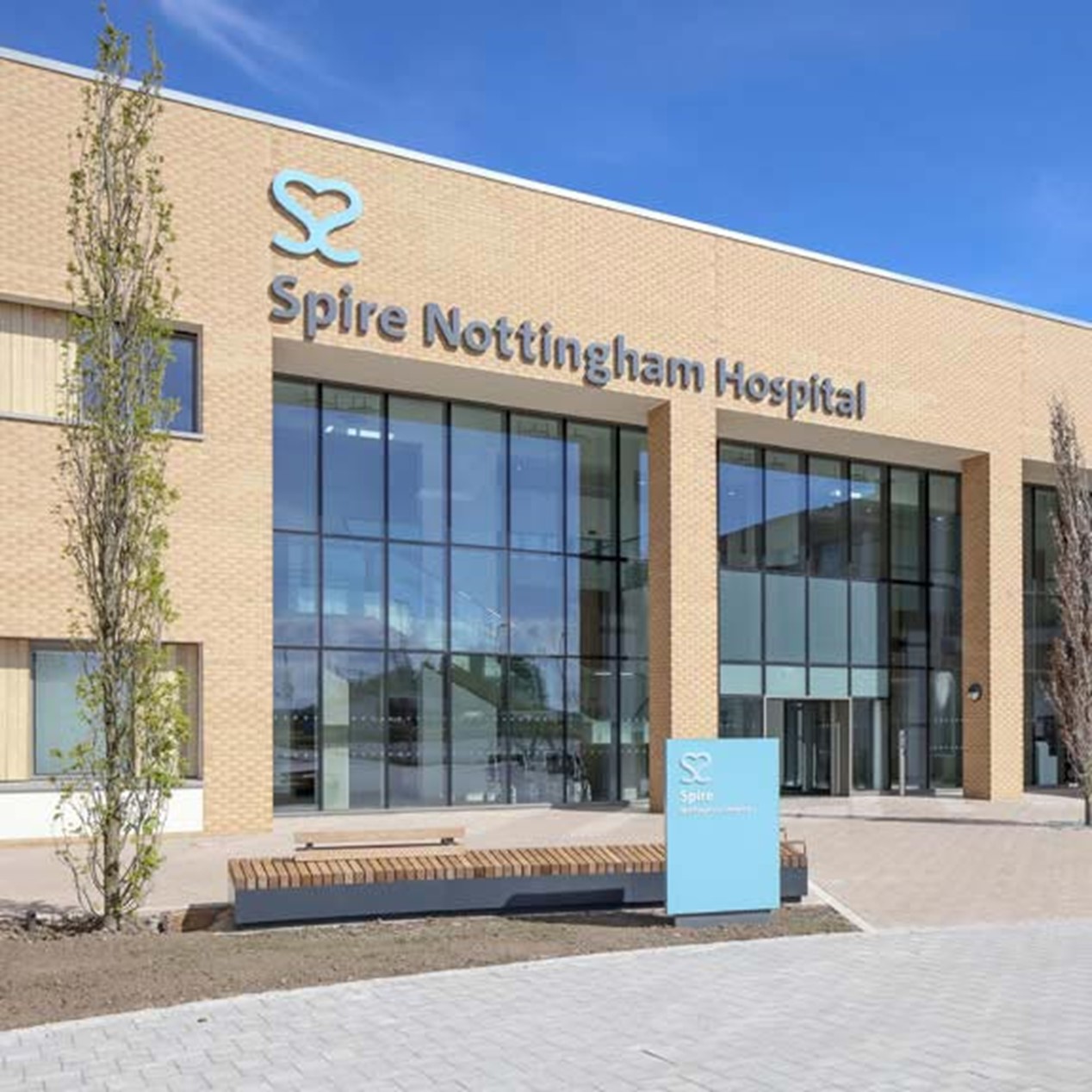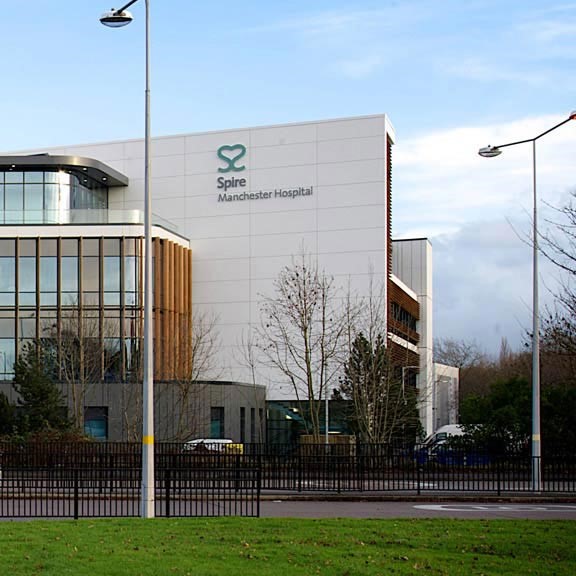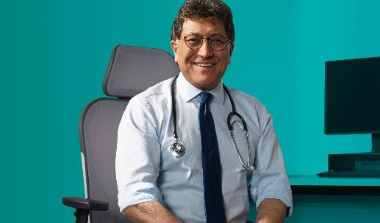A flexible sigmoidoscopy is a test that allows your doctor to look inside your rectum and the lower part of your bowel using a narrow, flexible, tube-like telescope called a sigmoidoscope. It can help detect inflammation, the presence of polyps and bowel cancer.
A referral letter from a consultant or GP is required before booking any diagnostic investigation.
Why you might need it
Your doctor may recommend a flexible sigmoidoscopy to find out what is causing symptoms such as changes in bowel habits (diarrhoea) or bleeding from your back passage. It is also used to check for inflammation, anal fistula, anal discharge, early signs of cancer and polyps.
During the procedure, your doctor may take one or more biopsies (samples of tissue) for examination in a laboratory.
If you decide to have your procedure with us, you will be looked after by an experienced multi-disciplinary care team.
Find a Spire hospital offering this treatment

Who will do it?
Our patients are at the heart of what we do and we want you to be in control of your care. To us, that means you can choose the consultant you want to see, and when you want. They'll be with you every step of the way.
All of our consultants are of the highest calibre and benefit from working in our modern, well-equipped hospitals.
Our consultants have high standards to meet, often holding specialist NHS posts and delivering expertise in complex sub-specialty surgeries. Many of our consultants have international reputations for their research in their specialised field.
Before your treatment
You will need a referral letter from a consultant or GP before booking any diagnostic investigation.
You will have a formal consultation with a healthcare professional. During this time you will be able to explain your medical history, symptoms and raise any concerns that you might have.
We will also discuss with you whether any further diagnostic tests, such as scans or blood tests, are needed. Any additional costs will be discussed before further tests are carried out.
Preparing for your treatment
We've tried to make your experience with us as easy and relaxed as possible.
For more information on visiting hours, our food, what to pack if you're staying with us, parking and all those other important practicalities, please visit our patient information pages.
Our dedicated team will also give you tailored advice to follow in the run up to your visit.
The procedure
We understand that having medical treatment can potentially be a time of anxiety and worry. Our experienced and caring medical staff will be there for you, holding your hand, every step of the way.
The procedure usually takes up to 10 minutes. It will feel uncomfortable, but shouldn't be painful.
While you're resting on your side, your doctor will gently examine your back passage with a gloved finger before carefully inserting the sigmoidoscope. Lubricating jelly will be used to make this as easy as possible.
Air is then usually pumped through the tube into your lower bowel to make it expand and the bowel wall easier to see. This may cause stomach cramps and you may get an urge to go to the toilet or pass wind.
A camera lens at the end of the sigmoidoscope sends pictures from the inside of your bowel to a TV screen. Your doctor will look at these images. During the procedure, you may be asked to change your position, for example, turning from your side onto your back. This helps your doctor to examine different areas of the bowel more easily.
Your doctor may take one or more biopsies (samples of tissue) for examination in a laboratory using special instruments passed inside the sigmoidoscope. If necessary, it’s possible to remove polyps during the procedure.
Aftercare
A flexible sigmoidoscopy is routinely done as an out-patient or day care procedure depending on the hospital, so you won't need to stay in hospital.
After the procedure, you may feel bloated and have stomach cramps, but these usually clear up quickly. You may also have a little blood in your faeces.
Before you go home, your doctor may explain if they found anything inside your bowel during the procedure. If you have had a biopsy or polyps removed, the results will be ready in a few days. You may be given a date for a follow-up appointment or the results will be sent to the doctor who requested your flexible sigmoidoscopy and they will discuss them with you.
On rare occasions, complications following a flexible sigmoidoscopy can occur. If you experience any of these symptoms – bleeding, or continuing abdominal pain or bloating – call us straight away. These can be signs that there is damage or, in very rare cases, that the lower bowel or rectum has been perforated during the procedure.
Occasionally, a sigmoidoscopy is not completed successfully and may need to be repeated. Your consultant will talk to you about the possible risks and complications of having this procedure and how they apply to you.
If you have any questions or concerns, we're here to help.
Why choose Spire?
We are committed to delivering excellent individual care and customer service across our network of hospitals, clinics and specialist care centres around the UK. Our dedicated and highly trained team aim to achieve consistently excellent results. For us it's more than just treating patients, it's about looking after people.
Important to note
The treatment described on this page may be adapted to meet your individual needs, so it's important to follow your healthcare professional's advice and raise any questions that you may have with them.
What is a flexible sigmoidoscopy?
A flexible sigmoidoscopy is a procedure to look inside the lower part of your large intestines (colon) — your descending colon, sigmoid colon and rectum. Your colon leads from your small intestine to your rectum and the sigmoid colon is the section of colon just before your rectum.
A flexible sigmoidoscopy is a type of endoscopy, which involves inserting a thin, flexible instrument called a sigmoidoscope into your rectum. The sigmoidoscope has a light and a tiny camera at the end that produces video images of the inside of your colon. If necessary, tissue samples (biopsies) can be collected via the sigmoidoscope.
A referral letter from a consultant or GP is required before booking any diagnostic investigation.
What is the difference between sigmoidoscopy and colonoscopy?
A flexible sigmoidoscopy is similar to a colonoscopy but simpler. The differences are:
- A colonoscopy looks at your entire colon, not just the lower part — this means that a flexible sigmoidoscopy alone can't detect growths, such as polyps, or cancer further along your colon
- A colonoscopy usually requires sedation, whereas you can have a flexible sigmoidoscopy without sedation
- The instruments used are different — a colonoscope is much longer than a sigmoidoscope
- The risk of complications, such as tearing the wall of the colon or rectum, is lower with a flexible sigmoidoscopy than with a colonoscopy
Alternatives to a flexible sigmoidoscopy
Depending on your symptoms and general health, your doctor may recommend a different type of endoscopy, such as a:
- Colonoscopy — similar to a flexible sigmoidoscopy but examines your entire colon, not just the lower part
- CT colonography — a CT scan of your colon, which is also called a virtual colonoscopy; during your CT scan gas will be gently pumped into your back passage to stretch your colon, which helps create clearer images
- Proctoscopy — similar to a sigmoidoscopy but only examines the very end of your colon
You may need more than one endoscopy to get a clear diagnosis.
How do I know if I need a flexible sigmoidoscopy?
A flexible sigmoidoscopy can be used to diagnose symptoms, such as:
- Abdominal pain
- Anal bleeding
- Changes to your bowel habits
- Chronic (long-term) or recurring diarrhoea
It can also look for inflammation or monitor conditions you’ve already been diagnosed with, such as:
- Bowel cancer
- Bowel polyps — non-cancerous growths
- Ulcerative colitis or Crohn’s disease — both cause inflammation of the colon
A flexible sigmoidoscopy can also be used to treat:
- Polyps — these can be removed using an instrument passed through the sigmoidoscope
- Volvulus — where your intestine becomes twisted, which blocks your bowel
Bowel cancer screening
A flexible sigmoidoscopy is also used to screen for colon and rectal cancer, as well as non-cancerous growths, such as polyps and adenomas, which may become cancerous if left untreated.
As part of the UK's bowel cancer screening programme, you may be offered a flexible sigmoidoscopy, referred to as a bowel scope screening, once every 5 years if you're aged 55 and over and have no other risk factors for colon or rectal cancer. This service is not yet available across the whole of the UK.
If you're aged over 55 and have other risk factors for colon or rectal cancer, your doctor will recommend more frequent screening.
Where to get a flexible sigmoidoscopy
Almost all of our hospitals offer flexible sigmoidoscopy. Our fast diagnostics mean you don’t have to wait long for your results. Find your nearest Spire hospital.

Preparing for a flexible sigmoidoscopy
A flexible sigmoidoscopy is usually an outpatient procedure, so you can return home on the same day as your procedure. If you have a sedative for your procedure, you need to arrange for someone to drive you home and stay with you for the rest of the day as the effects of the sedative wear off.
You need to empty your colon before your flexible sigmoidoscopy so that clear images can be obtained during your procedure. Your doctor will give you instructions on how to do this. You may need to:
- Not eat the day before your flexible sigmoidoscopy — you will still be able to drink clear liquids e.g. plain water, broth, fizzy drinks, tea and coffee without milk or cream
- Not eat or drink anything after midnight the night before your flexible sigmoidoscopy
- Take a laxative, either as a tablet or liquid, the night before your flexible sigmoidoscopy
- Use an over-the-counter enema kit a few hours before your flexible sigmoidoscopy — you may need to take two enemas to fully empty your colon; you may be asked to do this at home or have it done at the hospital or clinic
You may also need to adjust the dose of any medications you're taking or stop taking them entirely for up to a week before your flexible sigmoidoscopy. Remind your doctor of any medications or supplements you’re taking at least a week before your flexible sigmoidoscopy.
Your doctor will advise you on whether and when you need to stop taking them or if you need to change the dose. This is particularly important if you take diabetes medication, aspirin, blood thinners (eg clopidogrel, heparin and warfarin) or medications or supplements that contain iron — iron can cause constipation, which makes it difficult to empty your colon.
How a flexible sigmoidoscopy works
You’ll need to have a clear lower colon before the procedure so your doctor or nurse can see clearly. Your doctor or nurse will advise you on what you should do. You’ll probably need to have an enema, which you can do at home.
During a flexible sigmoidoscopy you will be given a gown to wear and be asked to lie down on your left side with your knees bent up towards your abdomen. You may also be given sedation to help you relax — this will be injected into a vein in your arm or hand.
Your doctor will examine your back passage, apply a lubricating gel and then gently pass the sigmoidoscope through your anus and into your lower colon. Gas will be passed through the sigmoidoscope and into your lower colon to allow a better view.
As the scope moves or air enters your colon you may feel the urge to open your bowels or experience some mild abdominal cramping — taking slow, deep breaths in can help you deal with the cramping. Although the procedure can be uncomfortable, it is usually not painful.
During your flexible sigmoidoscopy, video images will be captured via the small camera at the end of the sigmoidoscope. These images will be sent to a screen so your doctor can examine the inside of your colon. A biopsy may also be taken using instruments passed through the sigmoidoscope — the biopsy will be sent to a laboratory for further investigation. Polyps may also be removed.
If you are particularly uncomfortable during your flexible sigmoidoscopy, let your doctor know. They may stop your procedure or make adjustments to ease your discomfort. You may also be offered pain relief in gas form, which you can breathe in via a mouthpiece.
If you don’t have sedation, you’ll be able to go home shortly afterwards. If you have sedation, you’ll need to stay for an hour or so and avoid driving or operating machinery for 24 hours.
How long does a flexible sigmoidoscopy take?
A flexible sigmoidoscopy to investigate or diagnose a condition often takes less than 15 minutes. If you’re having flexible sigmoidoscopy to treat polyps, it can take longer and after your procedure, depending on the results, your doctor may refer you for a colonoscopy to examine the rest of your colon.
After a flexible sigmoidoscopy
You may experience some mild abdominal discomfort after your flexible sigmoidoscopy and feel bloated or pass gas due to the gas passed into your colon during your procedure. Walking can help ease your discomfort and you can return to your normal activities immediately after your procedure.
If you have had a sedative, you’ll need to stay at the hospital or clinic for an hour or so and avoid driving or operating machinery for 24 hours. You will also need someone to drive you home and stay with you for the rest of the day.
If a polyp is found during your procedure, your doctor may refer you for a colonoscopy to examine the rest of your colon and check for any further polyps.
Flexible sigmoidoscopy results
A healthcare professional trained in flexible sigmoidoscopy will carry out your procedure. They may be able to tell you the results straight away or they’ll send a report to the doctor who requested your flexible sigmoidoscopy.
If a biopsy was taken, it can take a few days to get the results from the laboratory. We try to get your results back to you as soon as possible as less waiting means less worrying.
Your results will either be negative or positive. A negative result means no abnormalities were found in your lower colon. If you’re aged 55 or over and have no other risk factors for colon or rectal cancer, you may be invited back for another flexible sigmoidoscopy in 5 years.
A positive result means polyps or other abnormal tissue were found in your lower colon. You may need more tests, such as a colonoscopy, to further examine the abnormalities, collect biopsies and/or remove the abnormalities. During a colonoscopy, the rest of your colon will be examined to check for any further abnormalities.
Flexible sigmoidoscopy side effects and risks
A flexible sigmoidoscopy is a relatively safe test with minimal discomfort. However, as with any procedure, there is a small risk of complications.
You may experience a small amount of bleeding if you had a biopsy taken. Occasionally, the sigmoidoscope may damage the lining of your colon causing:
- A tear — although this is rare
- Bleeding
- Infection
If you have had a sedative, you will be asked to remain at the hospital or clinic for an hour or so. This is because sedatives can occasionally cause complications, such as difficulty breathing and a drop in your blood pressure and heart rate.
You should contact your healthcare team where you had your flexible sigmoidoscopy immediately if you feel unwell or experience:
- Blood in your stools
- Fever
- Heavy or continuous bleeding from your back passage
- Severe pain
At Spire Healthcare, we’re careful to weigh up the benefits and risks of any endoscopy and discuss it with you if you have any concerns.
Frequently asked questions
Is it normal to have diarrhoea after a sigmoidoscopy?
Occasionally, a flexible sigmoidoscopy can cause diarrhoea for several days after the procedure until your colon returns to its normal state.
Why have a sigmoidoscopy instead of a colonoscopy?
A sigmoidoscopy is less invasive than a colonoscopy and has a lower risk of tearing the wall of the colon or rectum.
The treatment described on this page may be adapted to meet your individual needs, so it's important to follow your healthcare professional's advice and raise any questions that you may have with them.
Get in touch
Sources
https://www.mayoclinic.org/tests-procedures/flexible-sigmoidoscopy/about/pac-20394189
https://www.webmd.com/colorectal-cancer/flexible-sigmoidoscopy
https://www.bupa.co.uk/health-information/cancer/sigmoidoscopy
https://www.nnuh.nhs.uk/departments/gastroenterology/procedure-information/flexible-sigmoidoscopy/

